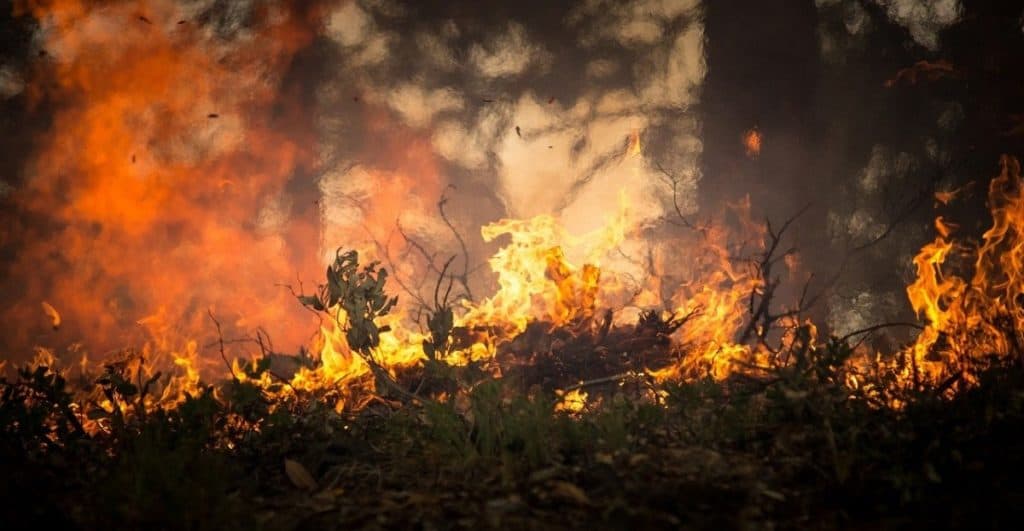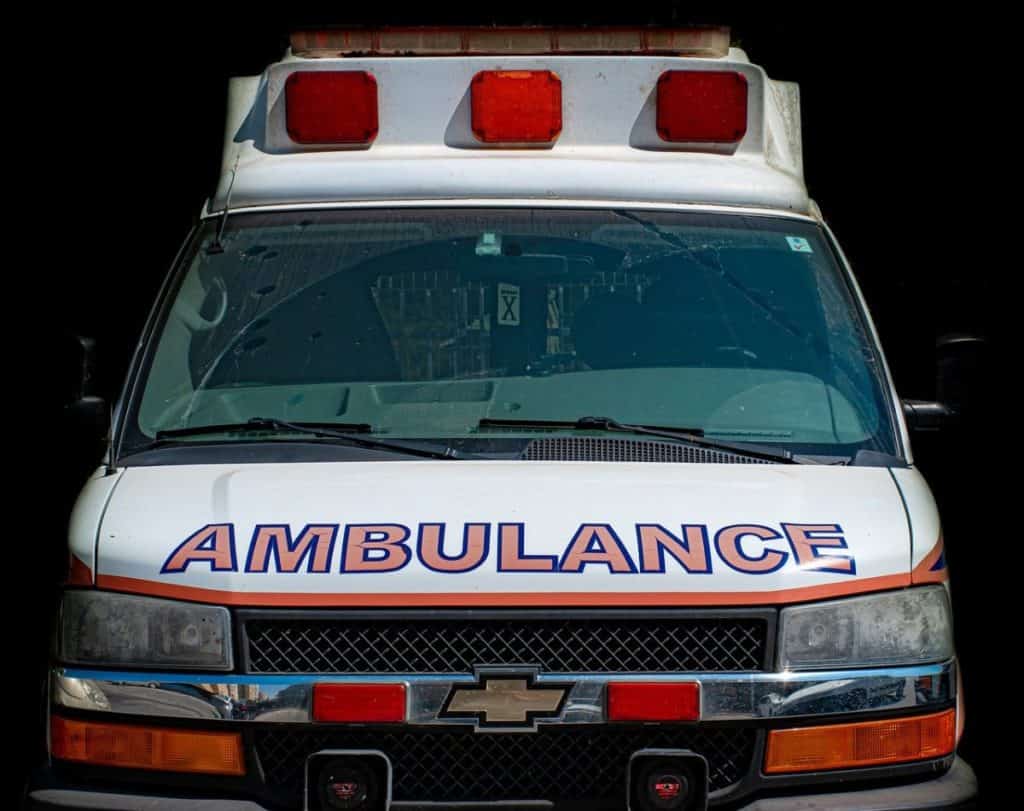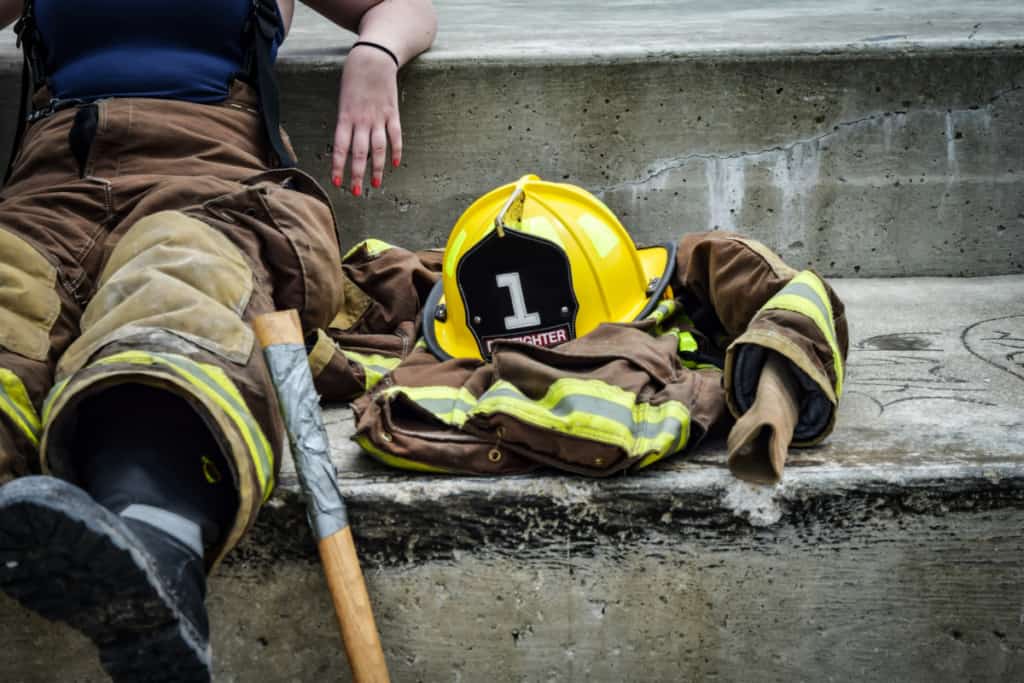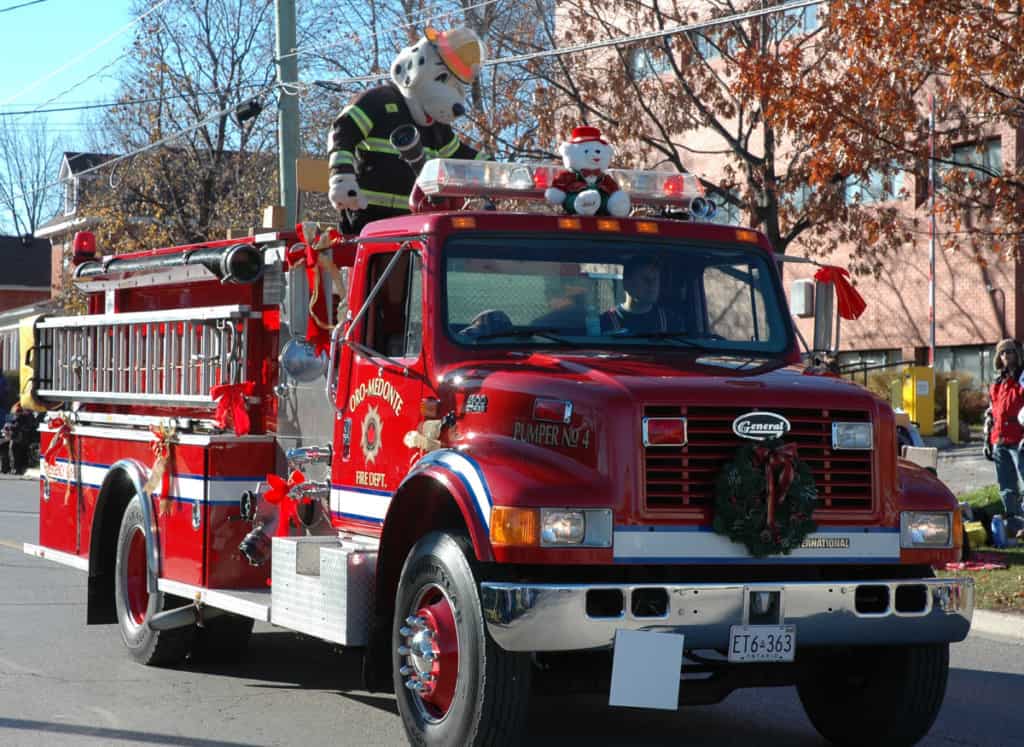A career as a firefighter is extremely rewarding and allows you the chance to give back to your community. Yet, only about 33% of firefighters are considered “career firefighters.” That’s because becoming a firefighter is not for everyone and is a very competitive career to get into.
Here’s a brief overview of how to become a firefighter.
- Earn accredited CPR and EMT training.
- Begin applying for open firefighter positions.
- Pass the written and physical exams.
- Nail the panel and chief interviews.
- Pass medical and background screenings.
- Begin your job as a probationary firefighter.
The first thing you need to do is make sure that you meet the basic educational requirements. The more education you have, the greater opportunity to advance to better positions.
Your # 1 priority is keeping your family safe. As a firefighter, I recommend everyone has updated smoke detectors that don’t require battery changes, like these ones from Kidde, a fire extinguisher, like this one from Amerex, and a fire escape ladder if you have bedrooms above the first floor, I recommend this one from Hausse.
Also read: Is it Hard to Become a Firefighter?
Education
All potential firefighter candidates must have a high school diploma or an equivalent degree (i.e. GED). Additionally, you must be at least 18 years old, though some departments have a minimum age requirement of 21, so check with your local stations.
Also read, What is the Age Limit to Become a Firefighter?
As of 2020, most fire departments now require their firefighters to have an EMT or a paramedic certificate to be able to properly respond to emergency calls. But, you also have the option to get a college degree or get your Firefighter 1 training from your local college’s fire academy for even more career opportunities.
College – Fire Science or Fire Technology

You don’t need any type of degree to become a firefighter, but it could help you to gain some background knowledge on the career and make you a more qualified applicant. Here are two types of degrees you can pursue.
- Fire Science. This is the most direct form of college training and can earn you a certificate, associate’s degree, or bachelor’s degree. These programs typically focus on hands-on training at local fire stations and medical training you might need in the field.
- Fire Prevention and Safety Technology. This will usually earn you an associate’s degree. This type of program tends to focus on the actual prevention of fires and allows you to get involved with local businesses and fire service groups to learn about safety.
Getting some form of degree or certificate will allow you to have some background knowledge on the field before you even begin applying for jobs.
Also read: What Do/Should Firefighters Major In? Firefighter College Degrees
CPR Training
It’ll be hard to find a fire department in America that doesn’t require you to get certified in CPR and AED. For the most part, a Basic Life Support (BLS) certification from the American Red Cross or American Heart Association covers this requirement.
These certifications last for two years, meaning you’ll have to retake the course every two years. The courses usually cover CPR, AED, obstructed airways, the basics of the EMS system, medical precautions, and other basic life-saving techniques.
The American Red Cross offers two types of courses. Here’s what each consists of.
- Blended learning. This is a self-paced online course that you can do at your own leisure. The only time you’ll have to meet with an instructor is when you’re taking the skills test.
- In-person. This is the basic classroom-setting that allows you to learn directly from a trained professional in-person.
Just head over to the American Red Cross website to find local course offerings near you. They’re usually offered year-round and you can find a class that best fits your schedule.
EMT School
Every year, the number of medical emergencies that firefighters respond to increases drastically. That’s exactly why a majority of American fire departments require EMT training for their firefighters.
Also read: Why Do Firefighters Go to Medical Calls?
To become an Emergency Medical Technician (EMT), you need to have a high school diploma (or a GED) and a valid CPR certification. You have to register for a local accredited EMT program and complete between 120 and 150 hours of training.
You’ll learn through lectures, hands-on training demonstrations, and internships with local organizations. Once you pass the course, you need to pass the 70 to 120 question EMT cognitive exam, which usually lasts about two hours.
This test is computer-based and covers all types of emergency response protocols, with about 85% of the test being based on adult and geriatric care. After you pass the test you will need to get a State EMT certification.
Also read: How to Become an EMT: Expert Guide
Paramedic School
EMT training is typically the “gold standard” for firefighter medical training, but many departments are now shifting gears and requiring paramedic training as well.
Paramedic training is a little bit different than EMT training. Paramedic school is a lot more intense since paramedics have many more responsibilities and much deeper training in the medical field.
When you go to paramedic school, you’ll be spending a lot more time going over anatomy, physiology, and how to treat some more intensive conditions and injuries. You’re going to be spending about 1200 to 1800 hours in one of these programs.
Once you find an accredited program that’s near you, you’ll sit through lectures, hands-on demonstrations, and internships to learn all you need to know about treating patients at the scene. This type of training typically takes about a year to a year and a half.
The paramedic cognitive exam is a little longer than the EMT exam, at between 80 and 150 questions and lasting two and a half hours. Since the exam is much more intensive, you’ll also have six attempts to pass it (though you’ll be sent to remedial training after the third time).
Also read: Do Firefighters Have to Be Paramedics or EMTs?
College Fire Academy – Firefighter 1
The college fire academy is another great choice for getting some hands-on experience and earning your Firefighter 1 certificate. Here’s what you should expect from these types of programs.
- Lots of training. These college fire academies are usually worth between 15 to 30 college credits and have somewhere around 500 hours of instruction. It’s a huge time commitment, so be ready for that.
- Earned certificates. As you pass individual courses, you’ll also earn some stand-alone certifications that’ll help you to earn a job when you start applying. So, that also means you have to pass the written exams that come along with them.
- Field experience. You’ll be expected to affiliate with a local fire department for either six months full-time or a year part-time to get your actual firefighter 1 certification.
- Financial expenditures. These academies are funded by you, and the costs can vary. It’s possible that you’re going to have to rent or buy your own equipment for use during the academy. This can run you anywhere between a few hundred to a few thousand dollars.
The best thing about this type of program is that you have something to show for at the end of it. Most of the mini-courses or lessons you’ll be engaged in during the semester will also earn you certificates that those not enrolled in the academy won’t have.
This can make you more qualified for firefighter jobs, in fact, some departments are requiring a firefighter 1 certification to even apply. This will also help you to be prepared for all the basic firefighter skills once you do land the job. Better to not be doing something for the first time when your dream job is on the line.
Also read: Fire Academy 101: What to Expect and How to Prepare and Can You Fail the Fire Academy? Yes, Here’s How
Experience
Being a firefighter requires a ton of hands-on work and an understanding of rules and protocols. Yet, fire chiefs are looking for a crew with plenty of different skills and experiences that they can transfer over to being a successful firefighter.
So, any experience you might already have in the emergency medical field, as a volunteer firefighter, or in any other trade might just be what helps you to clinch your first real interview. It looks even better for you if you have some community volunteer experience. And really any life experience is seen as a benefit in firefighter candidates.
Emergency Medical (EMS)

Approximately 62% of emergency calls in America require firefighters to provide some sort of emergency care (BLS or ALS). That’s why having some experience working on an ambulance or within an emergency department can help you out.
This means spending some time as an EMT or a paramedic, which shouldn’t be too much to ask if you already have your certifications and training. Either of these jobs will help you with the following aspects of being a firefighter.
- De-escalating emergencies and calming victims
- Providing basic lifesaving measures
- Working directly with the public
- Engaging with a team of professionals (and learning from them)
Plus, it’ll look great in an interview when you can talk about your hands-on experience working with victims and patients with all sorts of injuries and illnesses.
Volunteer Firefighter
Becoming a volunteer firefighter is a great introduction to what it’s like to be a career firefighter. What’s even better is that, despite the “volunteer” title, some volunteer firefighters can earn money for each call and some tax breaks and other financial opportunities.
As a volunteer firefighter, you’ll need to be at least 16 years old (though most departments want their volunteers to be at least 18). Call up your local department to find out if they take volunteer firefighters and what their particular requirements are.
Send in an application and wait to hear back. If the fire department wants to bring you on board, they’ll offer (or send you to) training to learn the ins and outs of being a firefighter and spending days at the station. You may even get your firefighter 1 certification.
Keep in mind, you likely will still have to pass a background check and a physical exam by a doctor to prove that you’re fit for this type of position. Also, it’s required that you have a valid driver’s license.
Once you’re officially a volunteer firefighter, you’ll begin by performing some tasks around the station and hopping on board when calls come in.
Also read: How to Become a Volunteer Firefighter: A Guide
Other Related Jobs

Having some experience as a volunteer firefighter is great for showing your chief that you know how to do the job, but there are plenty of other personality traits and skills that are ideal in firefighters as well.
All fire chiefs want a well-rounded force. Each individual should bring something different and useful to the table, such as problem-solving skills, relatable personal experiences, organization tips, etc.
Here are some other related jobs that might just help you to become a firefighter.
- Trades. Most trades involve doing some sort of work with your hands and looking at the bigger picture. As a firefighter, you might be asked to clean or repair the trucks, create plans and strategies and then map them out, and figure out the source of a problem.
- Customer service. Being in customer service means engaging with the public and learning how to portray yourself as a professional. As a firefighter, you’ll need to learn how to de-escalate situations, demonstrate humility, and communicate effectively.
- Public service. Plenty of other public service jobs are great transitions to being a firefighter. You’ve already proven your ability to follow protocols and represent the community and government positively.
If you look deep enough, nearly all job and life experiences that you have can apply to firefighting. So, think about what specific skills you’ve developed during your work history and figure out how these skills can be useful when it comes to being a firefighter.
Community Service or Other Volunteer Experience
As a firefighter, it’ll basically be your job to give back to the community and provide care to those who really need it. That’s exactly why any fire chief will ask you about your community service experience and what you gained from it.
First things first, having community service or other volunteer experience will make you stand out in an interview. But, it’ll also show your fire chief that you’ve developed perspective and truly care about helping people (not simply the paycheck involved with being a firefighter).
So, if you haven’t already, try getting involved in your community and earning some community service hours before you start applying.
Hiring Process
Once you have all the training and past experiences that you need, it’s time to take the first steps toward actually getting hired as a firefighter. The first things you’re going to do are look for local job openings and send in some applications.
Then it’s time to schedule and pass your written and physical exams, get some interview requests into your calendar, and pass the necessary background and medical screenings. With a job offer in hand, it’s finally time to attend the fire academy and begin as a probationary firefighter.
Where to Find Fire Department Jobs
You can’t apply if you don’t have any jobs to apply for. Let’s go over some of the best fire department job resources that you can find online.
- Government Jobs This site lists hundreds of job openings across the United States. You can also set up an account, which will save all your info, so you can use it for each job application, without having to enter everything again.
- National Testing Network. This website has a few hundred offerings at a time and even has different positions available, including EMT, law enforcement, and corrections. The only issue is that you might not find any jobs listed in your state.
- Indeed. This is probably where you’ll find the widest selection of jobs. There are thousands of job postings to look over and you can even break the results down by your location, salary, and experience levels (i.e. You would choose “entry-level”).
- Fire Recruit. This is a great site that has thousands of firefighter jobs available at a time. Plus, they’re separated by position.
If there’s nothing in your area when doing using these resources, you might be better off searching locally online or calling up local stations to find out about position availability.
Application process
Since there are likely hundreds or thousands of people applying at the stations you’re looking into, you need to make sure you’re being very particular about how you fill your application out. There are plenty of guidelines for filling out the perfect application.
Also read: 7 Tips for Your Firefighter Application: Get the First Step Right
First, make sure you’re reading it completely and understand exactly what they’re asking of you. Set aside the appropriate documents that they’re asking for and make color copies of each to attach with your application.
You’re also going to need to attach a cover letter and a resume. Make sure both of these documents are tailored to being a firefighter, including relevant work experience, skills that can transfer over, and any certifications you may have earned.
Check for spelling and grammatical errors and make sure that all of your information is 100% accurate and truthful. Organize the documents in the right order (as specified) and then send those applications out. Make a copy of the application for yourself as you can use this later to make filling out the next application much easier.
Written Test
Since being a firefighter requires skills and knowledge, you need to prove that you’re fit for the job intellectually as well. So, you’re going to need to pass the civil service exam, sometimes called the firefighter exam or written test.
Also read: Firefighter Written Test: What to Expect and How to Prepare
This test usually has between 100 and 150 questions and lasts for less than three hours, though it really depends on your state and your department. You’ll usually need at least an 80% to pass.
Here are the most common sections of this written test.
- Mechanical reasoning (how to use tools and machines)
- Mathematics (high school level)
- Spatial orientation (maps, pictures, diagrams, and floor plans)
- Verbal (grammar, spelling, etc.)
- Reading comprehension (understanding and explaining of what you’ve read)
- Reasoning and judgment (logic)
- Observation and memory (being able to remember what you read or saw)
It’s very likely that the questions you find on the test aren’t about firefighting at all. This test was simply designed to test the skills you have and how you could apply them to firefighting.
For help studying for these tests, read: Best Firefighter Exam Prep Books and Tools
Physical Agility Test (CPAT)
While you’re waiting for your written exam test results to come in, go ahead and schedule the Candidate Physical Ability Test (CPAT). This is a pass/fail test that requires you to successfully complete eight different tests in exactly 10 minutes and 20 seconds or less.
Here are the eight events you will be expected to complete (while wearing a 50-pound vest).
- Stair climb (with added shoulder weights 75lbs total)
- Ladder raise and extension
- Hose drag
- Equipment carry
- Forcible entry
- Search
- Rescue drag
- Ceiling pull
Here is an orientation video of the CPAT test:
This isn’t the type of test that you can just show up to and expect to pass with flying colors. You might want to begin an intense cardio and strength training regiment to better prepare to pass this test.
For detailed information about training for this test, read: Tips for the Firefighter Physical Test: Passing the CPAT and The Fitness Requirements for a Firefighter – Explained
Interview (Oral Board)
The first interview/s will be a panel interview where you’ll be interviewed by community members and other firefighters. During this interview, you’ll be given time limits for questions, so make sure you use them appropriately while not dragging your answers out too long.
Also read: Tips for Firefighter Interviews
There are several different types of interview questions that you’ll be asked. You might be asked about your inspiration behind wanting to be a firefighter, what skills and experiences you might bring to the table, and how you’ve prepared to become a firefighter (now would be a good time to talk about any certifications you’ve earned).
Since this is a formal interview, make sure you’re dressing business professional. So, wear a suit (skirt or pantsuit for the ladies), get rid of any piercings, style your hair neatly, and practice good hygiene.
Also read: What to Wear to a Firefighter Interview: Attire for Getting Hired and Most Common Firefighter Interview Questions: Insider Info
Eligibility List
The scores from the written exam will be released a few weeks or months after you took the test. By then, your name will be placed on an eligibility list. The higher your name, the higher your score was.
Also read: What is a Firefighter Eligibility List?
The whole purpose of this list is to show fire departments who the most qualified firefighter candidates really are. But, you can also earn some “extra points” and get higher on the list for being a volunteer firefighter or even a veteran.
Chief’s Interview
If you get a call back from a fire department you already interviewed at, that means you’re probably going in for a fire chief interview. This is where you’ll meet one-on-one with the fire chief so they can get to know you and what you would bring to the department.
Overall, they want to see that you would make a good fit. If you stay professional and represent yourself well, you may be given a conditional job offer.
Conditional Job Offer
A conditional job offer means that you have the job, so long as you complete the next batch of requirements. In this case, that means passing medical screening and a background investigation.
Medical Screening
The medical screening process is based on standards set by the IAFC and the NFPA and it considers the tasks and duties you’ll be assigned as a firefighter. The standard used by most departments to determine who is medically fit to be a firefighter is NFPA 1582.
Here’s a list of the types of screenings you might have to undergo.
- Vital signs (blood pressure, pulse, weight)
- Bloodwork
- Regular checkup/exam procedures
- Family history
- Hearing and vision tests
- Questions about your lifestyle habits (drinking and smoking)
- Vaccinations
- Urine test (drug screening)
- Lung cancer screening
You know that being a firefighter is a physically demanding job, but it can also be demanding on your psyche. It’s likely that your department will require you to take and pass a psychological examination as well.
For the psychological evaluation, you’ll complete a written exam. Just look at the questions and answer them quickly and honestly (don’t spend time thinking about an answer). This test is pass/fail and will help to decide whether you’re a good fit for the job.
For more information about NFPA 1582 and the standards for the firefighter medical exam, read:
- Can You Be a Firefighter with a Disability? What You Should Know
- Can You Be a Firefighter with Hearing Loss/Hearing Aids?
- Do Firefighters Need Perfect Vision? Firefighter Vision Standards
Background Investigation
Since you’ll be representing the community, your fire chief will require you to pass a background check too. With this, they’ll verify your past employment history, any local or state criminal history you might have and require a drug test.
Also read: Can You Be a Firefighter with Past Drug Use?
If you have any history of violent crimes or drug offenses, you may be passed up for the job.
There’s also a possibility that you’ll have to pass a polygraph test in an attempt to better understand your integrity and character. During the polygraph, you’ll probably be asked about a potential criminal past, your personality traits, school and employment history, and drug and alcohol use.
Here is a video of a firefighter with tips for the background check:
Final Job Offer
Once you’ve passed all the requirements asked of you by your chief, you’ll receive a final job offer. Once you pass the fire department’s fire academy, you’ll officially be a firefighter.
Fire Department’s Fire Academy
The fire academy is a rigorous 10 to 24-week training program designed to teach new firefighters the basic protocols, knowledge, and strategies involved with being a firefighter. Expect to spend a minimum of 40 hours a week at the academy.
While attending the academy, you’ll spend a lot of time dressed in full gear, participating in training drills and hands-on demonstrations to put you in the shoes of a real firefighter. Also, don’t be surprised by the amount of running and fitness exercises you’ll be asked to do.
A lot of training will also be in the classroom. There, you’ll learn about the basic responses to emergency situations, how to use the equipment, and learn to work with a small group or a team to respond to emergencies.
To get a better idea what the fire academy is like, here is a video of academy week 3 from South Metro Fire Rescue in Colorado:
If you can last all the way until the end of the academy without being kicked out, you’ll graduate and earn your title as a “firefighter.”
Also read: Fire Academy 101: What to Expect and How to Prepare and Can You Fail the Fire Academy? Yes, Here’s How
Probation Period as a New Firefighter
For more information about probation, read: How Long is a Firefighter Probationary Period?
You’re officially a firefighter, but don’t expect to be thrown to the wolves just yet. For the first six months to two years, you’ll be referred to as a “probationary firefighter.”
This basically means that you’re at the lowest rank available in the station. You’ll be mentored by the more experienced firefighters and learn the duties and tasks required of firefighters by engaging with them hands-on. You will be tested frequently as you still have to prove you have what it takes to work as a professional firefighter.
Though this is the learning period and you’ll be learning the inner-workings of being a firefighter, you’ll still be allowed to go out on calls and respond to emergencies. You won’t spend all of your time mopping the floors or washing down the engine!
Also read: 35 Things All Firefighters Should Know
Conclusion
Becoming a firefighter is a very admirable decision. Yet, you need to be willing to put in the time and effort to meet all of the requirements and prove your worth for this highly sought after career title. Remember, here’s what you need to do.
- Learn basic medical training through EMT school and CPR training.
- Apply to jobs in your area.
- Pass the written test with at least 80% and ace the physical exam (CPAT).
- Go on a panel and chief interview and impress your interviewers.
- Get a job offer.
- Pass the required medical and background screenings to prove you’re a good fit for this position.
- Attend and graduate the fire academy.
Related Articles
The 11 Best Firefighter Personal Tools
How Long Does it Take to Become a Firefighter?

